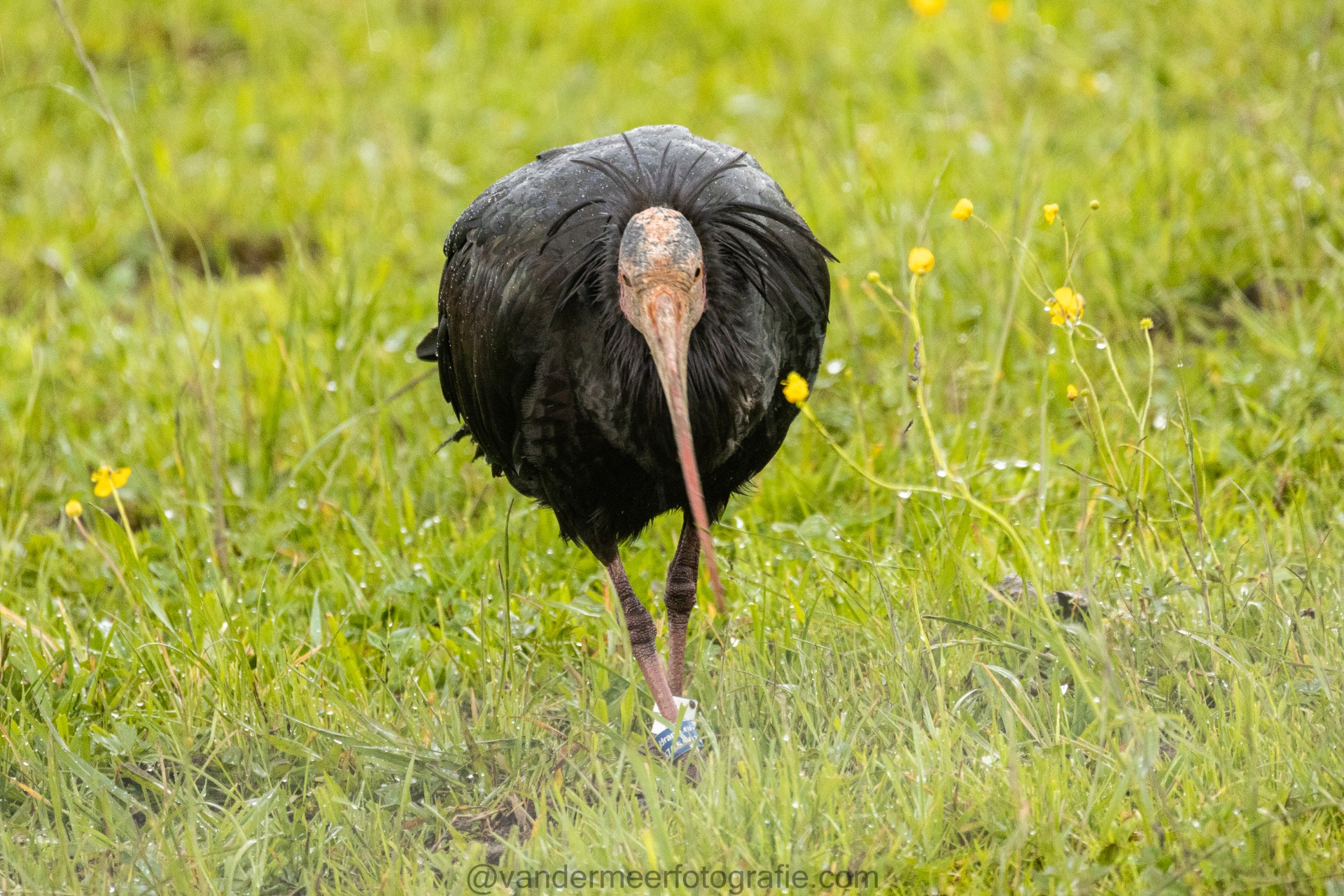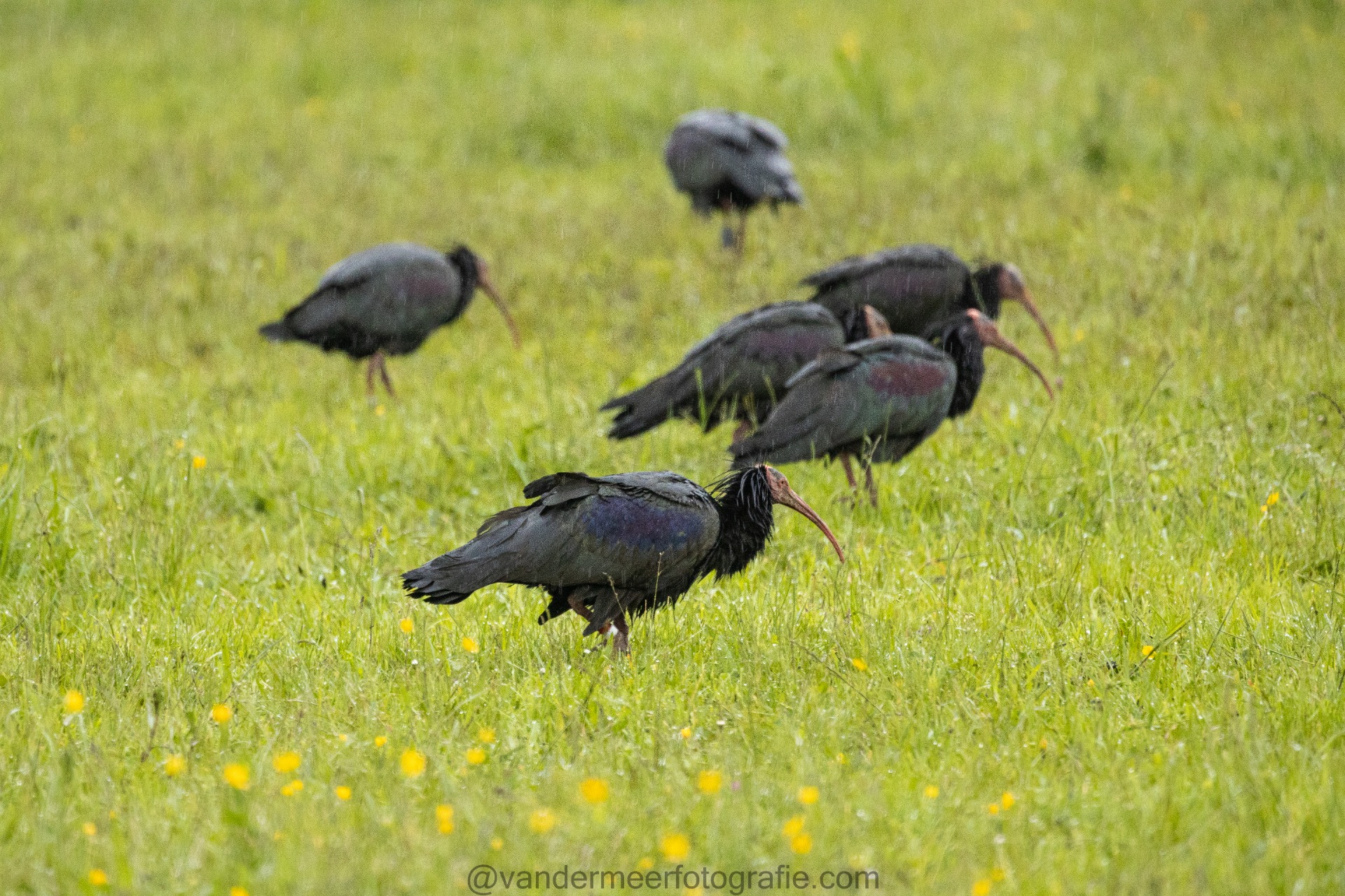NORTHERN BALD IBIS
A visit to the EU project (Life+Biodiversity),
The Return of the Waldrapp

Characteristics and behaviour of the Northern Bald Ibis.
The bald ibis really does look like a strange bird: the animal, about the size of a goose, has dark plumage, a bald head and a long, downward-curved, thin beak. The bald ibis belongs to the order of the walking birds, and they're to the family of ibises and spoonbills. It's about the size of a goose. The males measure around 75 centimetres from the head to the tail feathers, the females are slightly smaller at around 65 centimetres, but otherwise look exactly like the males. A Northern Bald Ibis can live to be 15 to 20 years old, some scientists suspect that some animals can even live for up to 30 years. The ibis lives in open landscapes such as steppes, but also on cultivated land, on meadows and pastures. The Northern Bald Ibis lives in groups of twelve to over a hundred animals. The birds are very sociable and have distinctive social behaviour. When they meet at their nesting rocks or resting places, the first thing they do is look for their partner. Once the two have found each other, they greet each other by putting up their feathers, throwing their heads back and bowing. They repeat this several times and shout out loud. When a couple begins with this greeting, all other couples in the colony soon join the ritual. Northern Bald Ibises are mostly peaceful, only the males now and then argue with each other if one of them comes too close to a strange nest or tries to steal nesting material. But it hardly ever happens that the animals are injured in the process. Northern bald ibises are migratory birds that have to learn from their parents how to get to their winter quarters and back. The birds weigh up to 1.5 kilograms. The plumage is deep black and has a metallic greenish to bluish sheen. The feathers on the shoulders have a slightly reddish to purple sheen. The plumage on the neck and belly is a little lighter that has a silvery shimmer. The face and forehead are bare and reddish in colour, only a few long feathers adorn the neck. The bird can set up this head of feathers. Most noticeable is the long red beak that curves downwards. The strong legs are also bare. Northern bald ibises only breed once a year, between March and June. Of course, the birds breed in their colony. Each couple builds a nest from twigs, grass and leaves on rock walls. There, the female lays two to four eggs.
The young hatch after about 28 days. They are fed not only by their parents, but also by other animals in the colony. The young are fully fledged after 45 to 50 days. However, they stay with their parents for a while and learn from them what they can eat and where to find food. The bald ibis lives almost exclusively on animal food: by poking the ground with its long beak, it looks for worms, snails, insects and insect larvae, spiders and sometimes small reptiles and amphibians and even small mammals. But now and then it also eats plants.
The Northern Bald Ibis used to be common in parts of Europe. It occurred from the Balkans through Austria, Germany and France to Spain. But the birds were hunted very hard and eventually died out in Central Europe in the 17th century. The homeland of the Waldrapps is not limited to Europe: it also lives in North Africa as well as in the Middle East and Northeast Africa, for example in Ethiopia. Today, there are only a few animals left in the wild. They live in Morocco, Turkey and Syria.
That's why the project: Northern Bald Ibis in Europe!

Resettlement project with a role model
Since the spring of 2013, the worldwide population of wild bald ibises with intact migration behaviour has been reduced to a single individual in the Middle East. In fact, the bald ibis is extinct as a migratory bird. The Waldrappteam project is the first scientifically based attempt to reintroduce an extinct migratory bird species. A successful project can serve as a model for the conservation and settlement of other threatened migratory bird species.
The project executing agency is the Austrian development association Waldrappteam. A total of eight partners from Austria, Germany and Italy are involved. More than 120 bald ibises are expected to migrate between the northern Alpine foothills and Tuscany by 2019. A first small breeding colony could be established in Burghausen / Bavaria. Two further breeding colonies are planned in Kuchl / Salzburg and Überlingen / Baden-Württemberg. Starting in 2014, six human-led migrations from the various breeding areas to the common winter area in southern Tuscany (WWF Oasi Laguna di Orbetello) are planned.
Salzburg is one of the most famous historical breeding sites for the Northern bald ibis. The colony on Mönchsberg is mentioned frequently. Unfortunately, resettlement is no longer possible there, but suitable rock structures are available as breeding sites in the State of Salzburg.
In 2011, a human-led migration was carried out for the first time from the State of Salzburg, starting from a training camp in Anif. In 2013, bald ibises returned to Salzburg independently of Tuscany.
2014, the bald ibis returned to Salzburg. They were brought to an aviary on the Georgenberg in the municipality of Kuchl. The Georgenberg is an island rock in the Salzach Valley, about 15 km south of the city of Salzburg. The rock with numerous niches largely resembles the Mönchsberg in the city of Salzburg, which until the Middle Ages housed one of the largest breeding colonies in Europe.
Already in 2014, in the first year, there was breeding success for the first time on Georgenberg. The breeding birds raise their young in free flight. The birds and their offspring will leave the breeding area in August and migrate to Italy in September. In the winter area in Tuscany they meet their conspecifics from the breeding area Burghausen.
The objective for Salzburg as part of the LIFE + project was the establishment of an independent, migrating breeding colony with 40+ individuals by the end of 2019.









Update from 7/14/2021.
The Northern Bald Ibises had many young. Good to recognize by the still gray heads.



